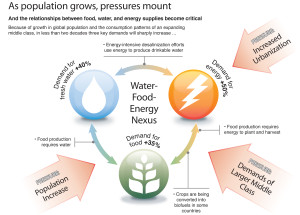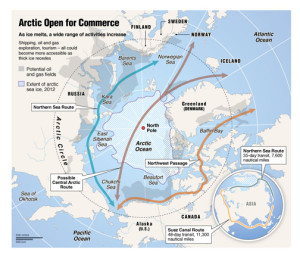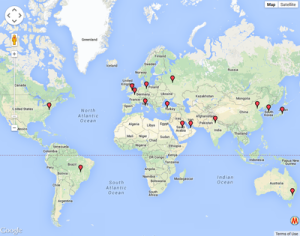What you will find on this page: LATEST NEWS; climate changes and (US) security issues; REPORT: Conflict vs Climate; cost of sanctioned violence (video); trends in military spending; climate change as a stressor; security & national interests (video); REPORT: Combat vs Climate; sanctioned violence; battle for resources
Latest News 21 July 2015, The Conversation, The march of the king crabs: a warning from Antarctica: Changing wildlife: this article is part of a series looking at how key species such as bees, insects and fish respond to environmental change, and what this means for the rest of the planet. Hundreds of metres below the surface of the freezing ocean surrounding Antarctica, the seafloor is teeming with life. The animals living there have no idea that an army is on the brink of invading their tranquil environment. The army is composed of king crabs. Until 2003, there were no crabs in this fragile Antarctic ecosystem. Now, driven by warming waters, their arrival heralds a major upset. The unique communities living on the continental shelf off Antarctica are found in no other place on Earth. Delicate brittle stars, beautiful sea stars, vibrant sea lilies, and giant sea spiders are among the spectacular inhabitants found there. The animals live side by side, with almost no predators to upset the balance. For millions of years, the cold water temperatures in the Antarctic have stopped most predators from surviving in this harsh environment. But this situation is rapidly changing. Read More here 21 July 2015, The Conversation, One year on from the carbon price experiment, the rebound in emissions is clear: Just over a year ago, Australia concluded a unique public policy experiment. For the preceding two years and two weeks, it had put a price on a range of greenhouse gas emitting activities, most significantly power generation. Now, 12 months since the price was removed, is a good time to assess the results of the experiment. The immediate effect of the carbon price was to increase the costs faced by most electricity generators, by an amount that varied between individual power stations depending on that station’s emissions intensity (the emissions per unit of electricity). These costs were then passed on in higher prices to consumers. Simple economics suggests that two effects should have followed. First, less emissions-intensive generators should have been able to increase their market share, resulting in an overall reduction in the average emissions intensity of electricity. Second, higher prices should have led consumers to reduce their consumption, cutting the total demand for electricity. When the price was removed, both of these effects should have been reversed. Let’s look at what happened in the National Electricity Market (NEM), which is the wholesale electricity market in every state and territory except Western Australia and the Northern Territory. My analysis, using detailed NEM operational data from the Australian Energy Market Operator (AEMO) finds that emissions intensity, which was increasing until shortly before June 2012, fell continuously (see graph below) for most of the two years to June 2014. Since then, it has increased consistently. All these changes were caused by changes in the market shares the different types of generation, just as expected. Read More here 20 July 2015, Science Daily, Changing climate lengthens forest fire season: Over a 35-year period, the length of forest fire seasons worldwide increased by 18.7 percent due to more rain-free days and hotter temperatures, according to research. The study examined weather data from 1979 through 2013 to determine how a changing climate impacts forest ecosystems. Over a 35-year period, the length of forest fire seasons worldwide increased by 18.7 percent due to more rain-free days and hotter temperatures, according to South Dakota State University professor Mark Cochrane, a senior scientist at the Geospatial Sciences Center of Excellence. The wildfire expert is part of a team of researchers led by W. Matt Jolly of the U.S. Forest Service Fire Science Laboratory that examined weather data from 1979 through 2013 to determine how a changing climate impacts forest ecosystems. “For things to burn, they have to have the proper conditions,” he explained. Four independent environmental factors increase the likelihood of wildfires — hotter temperatures, decreased relative humidity, more rain-free days and higher wind speeds. The researchers combined fire danger indexes from the United States, Canada and Australia with three global climate databases to create what Cochrane calls “an ensemble model.” They looked at the length of time and areas where conditions were conducive to fires. Their findings are published in Nature Communications. “Ecosystems are designed to withstand the normal climate situation, but we suspect that things aren’t normal anymore,” Cochrane said. On all the forested continents, except Australia, the fire seasons are getting longer, Cochrane explained. South America had the largest increase — 33 days in 35 years. In addition, the area affected by the longer fire season has doubled. Read More here 20 July 2015, WRI, An opportunity not to be wasted: The waste sector permeates almost every aspect of our society, and its mismanagement can lead to serious problems. Worldwide, we generated 1.3 billion tons of waste in 2012, which accounted forabout 5 percent of global greenhouse gas emissions. This volume is project to rise to 2.2 billion tons by 2025, with most of the increase expected in cities in the so-called emerging economies like Brazil, China, India, Mexico, and South Africa. The waste management utility sector is in the eye of the storm, and its evolution will be crucial to humanity’s response to various environmental challenges. As discussed in my previous blog in this series, the utility ecosystem is unable to respond to our social and environmental challenges because of entrenched interests, archaic infrastructure, systemic rigidities, and corporate inertia—all of which are painfully evident in the solid waste sector. Read More here End Latest News US/DNI Releases Report on Implications of Climate Change on National Security Since man first became aware of his neighbours “resources” war or more precisely “sanctioned violence” has been the mechanism for obtaining from others what you believe should be rightly yours. The battle for resources is not new and continues unabated in our supposed “civilised” world of today. With all the misery, lost lives, displaced peoples, wasted resources that war produces climate change has now added to this already complex mess. And as pressure builds to keep fossil fuels in the ground the battles to access and use them more apparently goes on. A bit like Golum and his “precious”…..What on earth are they thinking! There are many direct and indirect ramifications of war – all of which distract/undermine the capacity of the global community to respond in a concerted and positive way to the pandora’s box of climate change. Source: Center for Naval Analysis The cost of sanctioned violence Environmental Costs: The impact of the wars in Iraq, Afghanistan and Pakistan can be seen not only in the social, economic and political situations of these areas but also in the environments in which these wars have been waged. The long years of war have resulted in a radical destruction of forest cover and an increase in carbon emissions. In addition, the water supply has been contaminated by oil from military vehicles and depleted uranium from ammunition. Along with the degradation of the natural resources in these countries, the animal and bird populations have also been adversely affected. Read More here And what has this to do with climate change? It is adding to the problem. Human Costs: UNHCR’s annual Global Trends report, which is based on data compiled by governments, non governmental partner organizations, and from the organization’s own records, shows 51.2 million people were forcibly displaced at the end of 2013, fully six million more than the 45.2 million reported in 2012. “We are seeing here the immense costs of not ending wars, of failing to resolve or prevent conflict,” said UN High Commissioner for Refugees Antonio Guterres. “Peace is today dangerously in deficit. Humanitarians can help as a palliative, but political solutions are vitally needed. Without this, the alarming levels of conflict and the mass suffering that is reflected in these figures will continue.” Read More here. Access Global Emergency Overview here. Civilians Killed and Wounded:The ongoing conflicts in Iraq, Afghanistan and Pakistan have taken a tremendous toll on the people of those countries. At the very least, 174,000 civilians have been determined to have died violent deaths as a result of the war as of April 2014. The actual number of deaths, direct and indirect, as a result of the wars are many times higher than this figure. And what has this to do with climate change? It is often stated that the “vulnerable” are the ones that will suffer the most in facing the impacts of climate change as they have not the resources or resilience to adapt or “bounce back”. The futility of war has literally placed over 50 million people, to date, into this vulnerable category and have denied them the opportunity to be part of the solution. A loss that the rest of the world must cover. Economic Costs: A quote from James Madison, Political Observations, 1795: “Of all the enemies to public liberty war is, perhaps, the most to be dreaded because it comprises and develops the germ of every other. War is the parent of armies; from these proceed debts and taxes … known instruments for bringing the many under the domination of the few.… No nation could preserve its freedom in the midst of continual warfare.” Nothing much has changed in 200+ years has it? Trends in World Military Expenditure 2014 Source: From 13 April 2015 the SIPRI Military Expenditure Database includes newly released information on military expenditure in 2014. This Fact Sheet describes the global, regional and national trends in military expenditure that are revealed by the new data. Look at the following map of the 15 leaders in military expenditure – and what questions come to your mind? Access map for further details here Trends in World Military Expenditure 2014 A sign of things to come? Climate change impacts becoming a “stressor” in conflicts Did Drought Trigger The Crisis In Syria? What caused the conflict in Syria to erupt when it did, pushing citizens from discontent with the regime to outright rebellion? One possibility is that environmental factors, particularly a long-lasting drought, helped ignite the crisis. Drought affected north-eastern Syria (as well as adjacent regions in Turkey and Iraq) from 2006 to 2011 and resulted in widespread food insecurity, malnutrition, internal displacement from agricultural areas, and the creation of shanty towns on the edges of cities. Read More here National/global security issues and climate change If the deniers want us to believe that climate change is a fabrication and it isn’t a problem then they forgot to convince those “looking after” the security interests of governments. Following are a number of reports that indicate that they are treating climate change as a high profile security issue. From the Center for Naval Analysis. In the videos below, CNA Corporation Military Advisory Board (MAB) members discuss the new report, National Security and the Accelerating Risks of Climate Change. In the first video, Brigadier General Gerald Galloway details how climate change impacts American national security and military readiness, affecting the lives of thousands of military personnel and American civilians around the U.S. In the second video, Admiral Frank “Skip” Bowman emphasizes how climate change is already impacting our national security and international military dynamics. The work of the MAB has been important in advancing the understanding that energy choices are not future threats—they are taking place now—and that actions to build resilience against the projected impacts of climate change are required today. US: National Security and the Accelerating Risks of Climate Change (2014): As a follow-up to its landmark 2007 study on climate and national security, the CNA Corporation Military Advisory Board’s National Security and the Accelerating Risks of Climate Change re-examines the impact of climate change on U.S. national security in the context of a more informed, but more complex and integrated world. The Board’s 2007 report described projected climate change as a “threat multiplier.” In this report the 16 retired Generals and Admirals who make up the board look at new vulnerabilities and tensions posed by climate change, which, when set against the backdrop of increasingly decentralized power structures around the world, they now identify as a “catalyst for conflict.” US 2014 Quadrennial Defense Review: A rather chilling document (a quote: ” The rapidly accelerating spread of information is challenging the ability of some governments to control their populations and maintain civil order.”) Note risk of climate change exec summary and pages 8 & 25. The impacts of climate change may increase the frequency, scale, and complexity of future missions, including defense support to civil authorities, while at the same time undermining the capacity of our domestic installations to support training activities… Climate change poses another significant challenge for the United States and the world at large…. Climate change may exacerbate water scarcity and lead to sharp increases in food costs. The pressures caused by climate change will influence resource competition while placing additional burdens on economies, societies, and governance institutions around the world. These effects are threat multipliers that will aggravate stressors abroad such as poverty, environmental degradation, political instability, and social tensions – conditions that can enable terrorist activity and other forms of violence.….The Department’s operational readiness hinges on unimpeded access to land, air, and sea training and test space. Consequently, we will complete a comprehensive assessment of all installations to assess the potential impacts of climate change on our missions and operational resiliency, and develop and implement plans to adapt as required. Climate change also creates both a need and an opportunity for nations to work together, which the Department will seize through a range of initiatives. We are developing new policies, strategies, and plans, including the Department’s Arctic Strategy and our work in building humanitarian assistance and disaster response capabilities, both within the Department and with our allies and partners. War – Sanctioned Violence/ protecting national security interest Thus, we take another step deeper into the tragedy of U.S. intervention in the Middle East that has become a noxious farce. Consider just one of the head-spinning subplots: We are allied with our declared enemy, Iran, against the bloody Islamic State, which was spawned from the chaos created by our own earlier decisions to invade Iraq and to overthrow the Assad regime in Syria, which has us fighting side-by-side with jihadist crazies financed by Saudi Arabia, whom we are supporting against the Houthis in Yemen, the bitter rivals of Al Qaeda — the perpetrators of 9/11! Read More here NOTE: For those readers that have got this far, if you wish to explore further the dysfunction of our world you may need to include the vast implications of organised crime and corporate and political corruption and the implications for climate change response as well. Climate change and national security issues
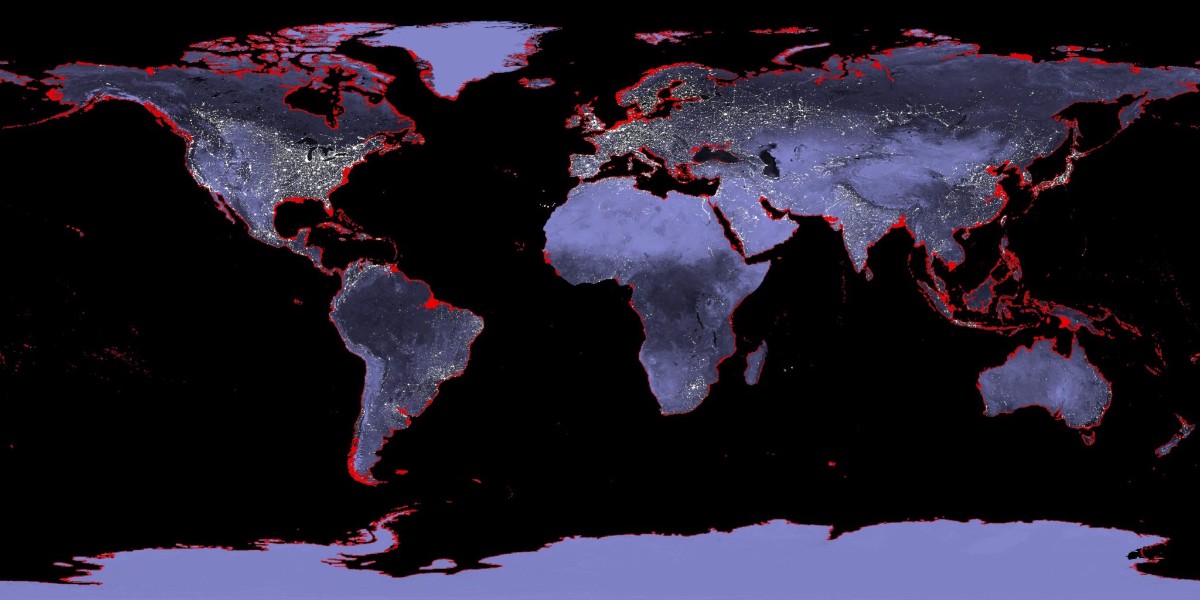 19 September 2016, American Security Project: The National Intelligence Council, part of the Office of the Director of National Intelligence, has just released a new White Paper titled “Implications for U.S. national security of Anticipated Climate Change.” The report analyzes the potential effects of climate change on national security in the coming 20 years. The report uses previous IPCC reports as a scientific baseline for analysis. The report begins with a strong assertion of the dangers of climate change for societies, economies, and governments across the world: t goes on to list some of the pathways to “wide-ranging national security challenges for the United States and other countries,” including “threats to the stability of countries, adverse effects on food prices and availability, and negative impacts on investments and economic competitiveness.” The report gives possible time-frames for these emerging national security challenges, suggesting that based on “changing trends in extreme weather,” the future will almost certainly hold more “climate related disruptions.” The majority of climate change-related risks to U.S. national security in the next five years will come from “distinct extreme weather events”, and “the exacerbation of currently strained conditions,” including water shortages. The report comes after years of significant research inside and outside of the government on climate security. The National Intelligence Council last released a report on this issue in 2009. Many in the security community have spoken on the emerging national security risks posed by climate change. ASP and countless other organizations have urged policy makers not to underestimate the security challenges posed by climate change and the rising seas. Read More here and access full report here
19 September 2016, American Security Project: The National Intelligence Council, part of the Office of the Director of National Intelligence, has just released a new White Paper titled “Implications for U.S. national security of Anticipated Climate Change.” The report analyzes the potential effects of climate change on national security in the coming 20 years. The report uses previous IPCC reports as a scientific baseline for analysis. The report begins with a strong assertion of the dangers of climate change for societies, economies, and governments across the world: t goes on to list some of the pathways to “wide-ranging national security challenges for the United States and other countries,” including “threats to the stability of countries, adverse effects on food prices and availability, and negative impacts on investments and economic competitiveness.” The report gives possible time-frames for these emerging national security challenges, suggesting that based on “changing trends in extreme weather,” the future will almost certainly hold more “climate related disruptions.” The majority of climate change-related risks to U.S. national security in the next five years will come from “distinct extreme weather events”, and “the exacerbation of currently strained conditions,” including water shortages. The report comes after years of significant research inside and outside of the government on climate security. The National Intelligence Council last released a report on this issue in 2009. Many in the security community have spoken on the emerging national security risks posed by climate change. ASP and countless other organizations have urged policy makers not to underestimate the security challenges posed by climate change and the rising seas. Read More here and access full report here
10 November 2015, Yale Connections: Drought, water, war, and climate change” is the title of this month’s Yale Climate Connections video (above) exploring expert assessments of the interconnections between and among those issues. With historic 1988 BBC television footage featuring Princeton University scientist Syukuru (“Suki”) Manabe and recent news clips and interviews with MIT scientist Kerry Emanuel, Ohio State University scientist Lonnie Thompson, CNN reporter Christiane Amanpour, and New York Times columnist and book author Tom Friedman, the six-minute video plumbs the depths of growing climate change concerns among national security experts. Source: Yale Connections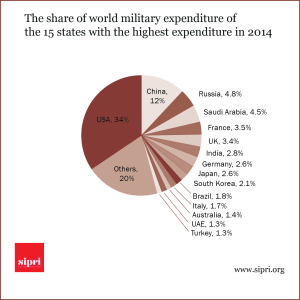 Total world military expenditure in 2014 was $1776 billion. This is equivalent to 2.3 per cent of global GDP. According to the SIPRI Military Expenditure Database, Australia is ranked at number 13 as the biggest spender for 2014.Total Australia spending AUD29.3 billion ($b.,MER) 25.4. Share of GDP 1.8%. Share of world military expenditure 1.4%
Total world military expenditure in 2014 was $1776 billion. This is equivalent to 2.3 per cent of global GDP. According to the SIPRI Military Expenditure Database, Australia is ranked at number 13 as the biggest spender for 2014.Total Australia spending AUD29.3 billion ($b.,MER) 25.4. Share of GDP 1.8%. Share of world military expenditure 1.4%
And what has this to do with climate change? It goes with out saying that responding to climate change and transforming the energy and economic systems of the world in a carbon restricted world would be made a lot easier on everyone if military budgets were focused on what could help the world rather than plunder it. 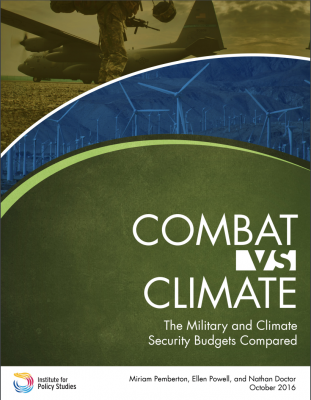 5 October 2016. The Military and Climate Security Budgets Compared. Fifteen of the sixteen hottest years ever recorded have occurred during this new century, and the near-unanimous scientific consensus attributes the principal cause to human activity. The U.S. military’s latest National Security Strategy says that climate change is “an urgent and growing threat to our national security, contributing to increased natural disasters, refugee flows, and conflicts over basic resources like food and water.” What they don’t say is that the overall balance of U.S. security spending should be adjusted to fit that assessment. And we know less about how much we are spending on this urgent threat than we used to, since the federal government hasn’t produced a climate security budget since 2013. In this new report, Combat vs. Climate, the Institute for Policy Studies steps in to provide the most accurate climate change security budget currently available, drawing data from multiple agencies. And it looks at how these expenditures stack up within our overall security budget. Then, the report ties the military’s own assessment of its urgent threats to a budget that outlines a “whole of government” reapportionment that will put us on a path to averting climate catastrophe. This is our status quo: As global temperatures hit one record after another, the stalemate in Congress over funding to respond continues. Climate scientists warn that, as in Syria, unless the global greenhouse gas buildup is reversed, the U.S. could be at risk for conflicts over basic resources like food and water. Meanwhile, plans to spend $1 trillion to modernize our entire nuclear arsenal remain in place, and projected costs of the ineffective F-35 fighter jet program continue to climb past $1.4 trillion. Unless we get serious about moving the money, alarms from all over about the national security dangers of climate change will ring hollow. Access article here. Access report here.
5 October 2016. The Military and Climate Security Budgets Compared. Fifteen of the sixteen hottest years ever recorded have occurred during this new century, and the near-unanimous scientific consensus attributes the principal cause to human activity. The U.S. military’s latest National Security Strategy says that climate change is “an urgent and growing threat to our national security, contributing to increased natural disasters, refugee flows, and conflicts over basic resources like food and water.” What they don’t say is that the overall balance of U.S. security spending should be adjusted to fit that assessment. And we know less about how much we are spending on this urgent threat than we used to, since the federal government hasn’t produced a climate security budget since 2013. In this new report, Combat vs. Climate, the Institute for Policy Studies steps in to provide the most accurate climate change security budget currently available, drawing data from multiple agencies. And it looks at how these expenditures stack up within our overall security budget. Then, the report ties the military’s own assessment of its urgent threats to a budget that outlines a “whole of government” reapportionment that will put us on a path to averting climate catastrophe. This is our status quo: As global temperatures hit one record after another, the stalemate in Congress over funding to respond continues. Climate scientists warn that, as in Syria, unless the global greenhouse gas buildup is reversed, the U.S. could be at risk for conflicts over basic resources like food and water. Meanwhile, plans to spend $1 trillion to modernize our entire nuclear arsenal remain in place, and projected costs of the ineffective F-35 fighter jet program continue to climb past $1.4 trillion. Unless we get serious about moving the money, alarms from all over about the national security dangers of climate change will ring hollow. Access article here. Access report here.

